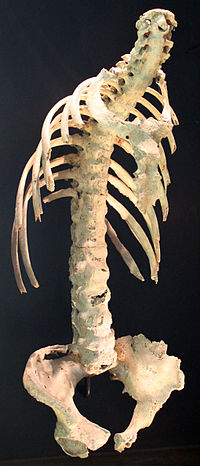
Photo from wikipedia
The use of tumour necrosis factor inhibitors (TNFi) has advanced the clinical management of rheumatoid arthritis (RA). However, only 30-40% of patients who receive initial treatment with a TNFi experience… Click to show full abstract
The use of tumour necrosis factor inhibitors (TNFi) has advanced the clinical management of rheumatoid arthritis (RA). However, only 30-40% of patients who receive initial treatment with a TNFi experience a beneficial response. The discovery of reliable biomarkers of TNFi response is, therefore, a priority. Whilst T-cell dysfunction is documented in RA pathophysiology, T-cell involvement in TNFi treatment response is unclear. We aimed to phenotype peripheral blood-derived T-cells in RA patients over a number of time-points through the first 12-weeks of TNFi treatment; and to apply a cluster-free association testing method developed on single-cell CITE-seq data—co-varying neighbourhood analysis (CNA)—to high-dimensional single-cell CyTOF data. 16 TNFi-naïve RA patients commenced treatment with a TNFi (10 on Adalimumab, 6 on Etanercept) and peripheral blood samples were collected at 6-7 time-points between pre-treatment and 12-weeks. Peripheral blood mononuclear cells were extracted, and stained with a 35-marker CyTOF panel. Treatment response was classified using the EULAR response criteria, and patients were characterised as good, moderate or non-responders. Data were cleaned in FlowJo and analysed using both i) a cluster-based approach, where data were clustered into 12 populations, and linear mixed models were fitted per cluster to test for significant differences in population abundance and ii) a cluster-free approach called CNA where association testing is purely data-driven. Both analyses controlled for age, sex, type of TNFi and TNFi concentration. Cluster-based analysis showed at 12-weeks, 1 of the 12 clusters (CD4+CD39+HLA-DR+) significantly increased in abundance in the non-responder cohort compared to the good and moderate responders (adjusted p = 0.037). Interestingly, HLA-DR and CD39 genetic effects have previously been associated with TNFi response. No significant differences were observed with CNA. These results demonstrate that significant differences in T-cell abundance can be seen as early as 12-weeks after commencing treatment with a TNFi. Validation of these findings is required before the predictive value of this T-cell population can be tested. Disclosure M.A. Sutcliffe: None. S. Ling: None. A. Banyard: None. L. Rumker: None. S. Viatte: None. A. Morris: None. A. Barton: None. S. Raychaudhuri: None. D. Plant: None.
Journal Title: Rheumatology
Year Published: 2023
Link to full text (if available)
Share on Social Media: Sign Up to like & get
recommendations!